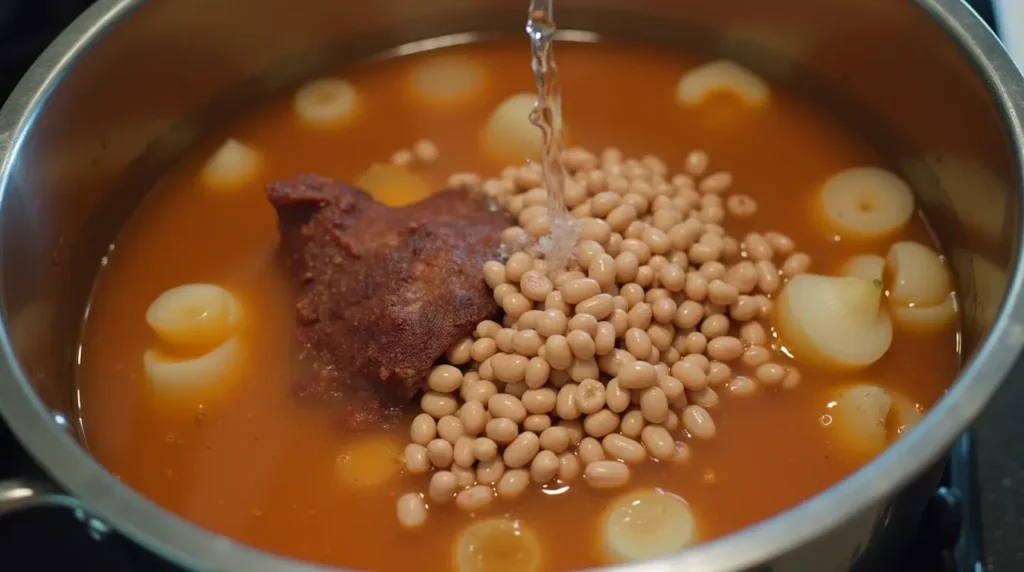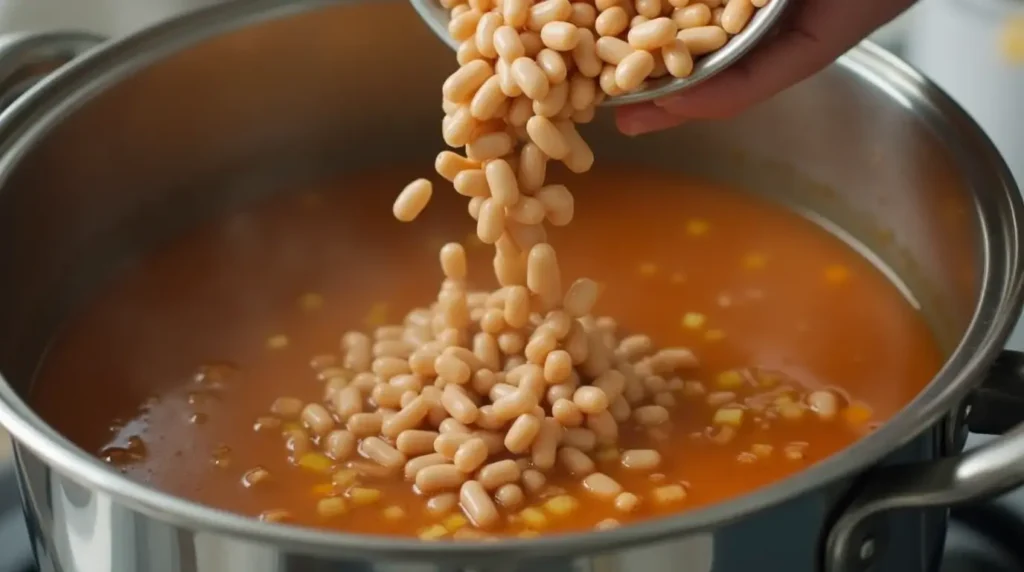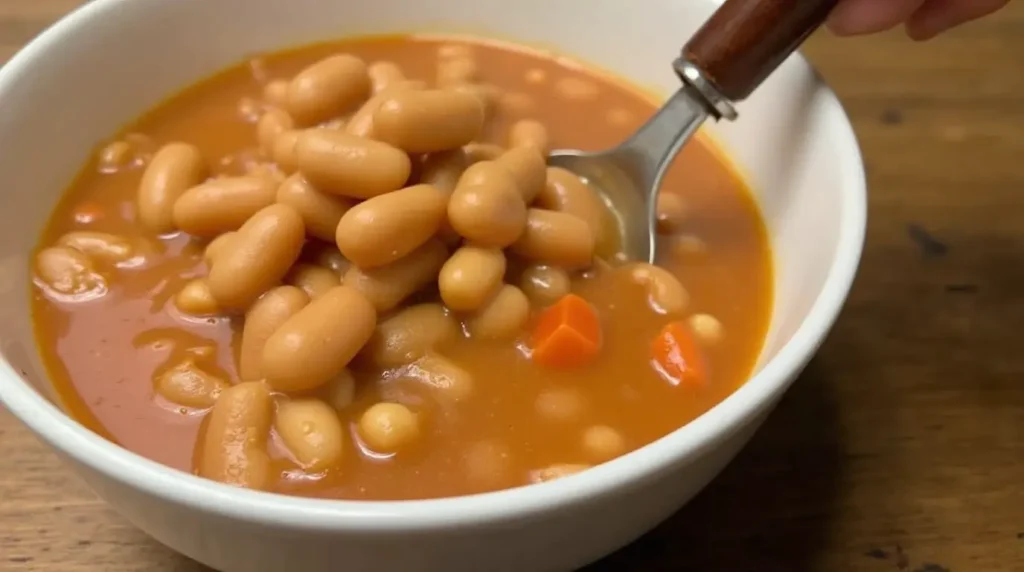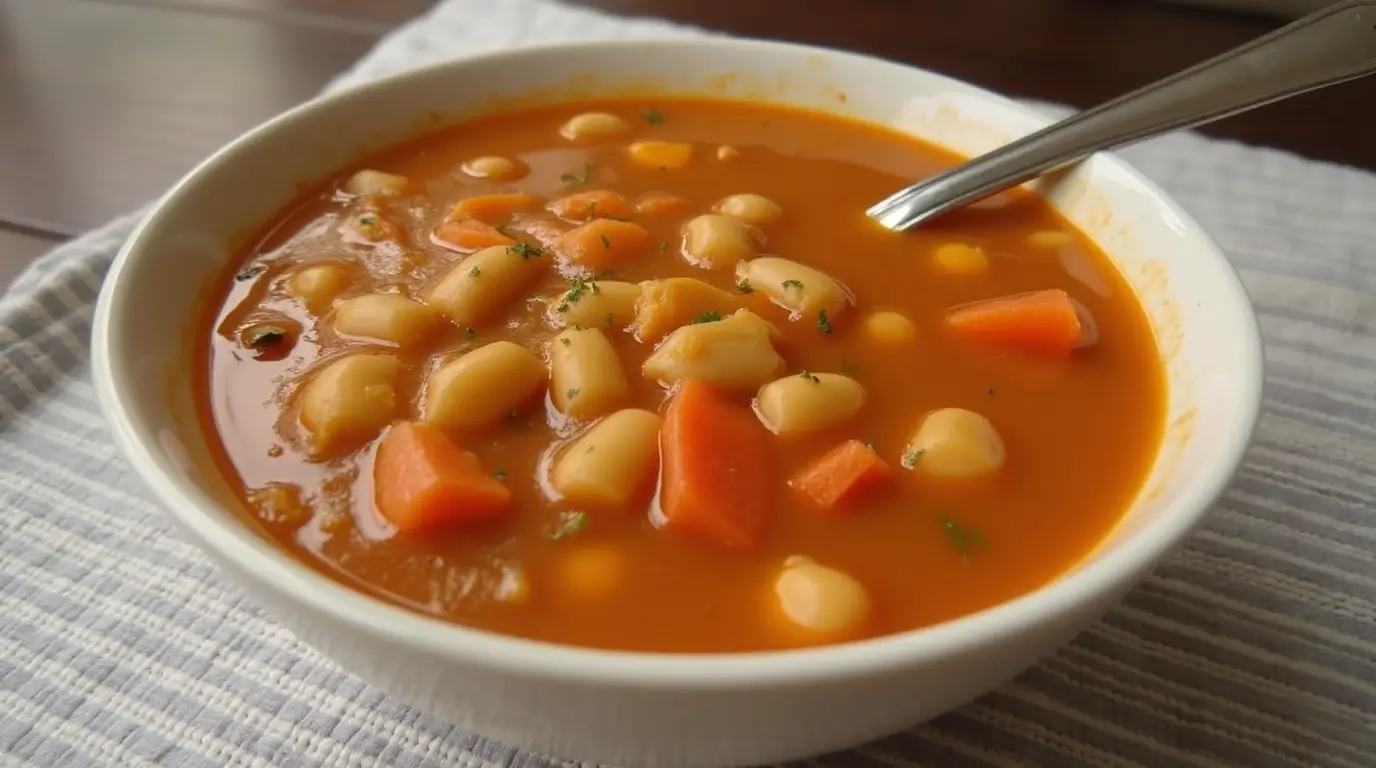Discover the simple pleasure of hearty Soup Beans! This guide covers everything from selecting the right beans to creating flavorful variations.
Introduction: Embracing the Simplicity of a Classic Dish Soup Beans
A pot of simmering beans is a humble yet deeply satisfying dish. It’s a staple in many cultures, offering nourishment and comfort. This guide will show you how to make a delicious and versatile version. Therefore, get ready for a comforting meal.
Print
Unlock Comfort: Mastering Delicious, Hearty Soup Beans
- Total Time: 2 hours 15 mins
- Yield: 6 servings 1x
- Diet: Vegetarian
Description
A warm and comforting bowl of hearty soup beans, simmered to perfection with simple yet rich flavors. Perfect for chilly days and cozy evenings.
Ingredients
2 cups dried pinto beans, rinsed and soaked overnight
1 tablespoon olive oil
1 medium onion, chopped
2 garlic cloves, minced
1 carrot, chopped
1 celery stalk, chopped
6 cups vegetable broth
1 bay leaf
1 teaspoon smoked paprika
Salt and pepper to taste
Fresh parsley for garnish (optional)
Instructions
1. Drain and rinse the soaked beans.
2. In a large pot, heat the olive oil over medium heat.
3. Add the chopped onion, garlic, carrot, and celery. Cook until the vegetables are soft, about 5 minutes.
4. Add the soaked beans, vegetable broth, bay leaf, and smoked paprika.
5. Bring to a boil, then reduce the heat and simmer uncovered for about 1 1/2 to 2 hours, or until the beans are tender.
6. Season with salt and pepper to taste.
7. Remove the bay leaf before serving.
8. Garnish with fresh parsley if desired.
Notes
For a meatier flavor, you can add smoked ham hocks or a meaty bone during simmering.
To thicken the soup, mash some of the beans against the side of the pot.
Serve with crusty bread or cornbread for a complete, comforting meal.
- Prep Time: 15 mins
- Cook Time: 2 hours
- Category: Soup
- Method: Simmer
- Cuisine: American
Nutrition
- Serving Size: 1 bowl
- Calories: 250
- Sugar: 4g
- Sodium: 500mg
- Fat: 5g
- Saturated Fat: 1g
- Unsaturated Fat: 4g
- Trans Fat: 0g
- Carbohydrates: 40g
- Fiber: 10g
- Protein: 12g
- Cholesterol: 0mg
Keywords: beans, soup, comfort food, hearty, vegetarian
What is This Dish? A Definition and History Soup Beans
A Simple Dish with Deep Roots
This hearty dish, at its core, involves beans simmered in liquid until tender. The broth becomes flavorful, creating a simple yet nourishing meal. Consequently, it’s a blank canvas for creativity.
Variations Across Cultures: A Global Staple
Many cultures have their own version of this dish. The specific beans and seasonings vary. However, the basic concept of slow-cooked beans remains the same.
Appalachian Pinto Beans: A Regional Specialty
In Appalachia, a version made with pinto beans is a cultural touchstone. Often served with cornbread, it’s a regional staple. Therefore, it represents a specific culinary tradition.
The History of Beans: An Ancient Food Source
Beans have been a vital food source for thousands of years. They are nutritious, versatile, and were domesticated worldwide. Consequently, they are a global staple.
Choosing the Right Beans for Your Pot Soup Beans

Pinto Beans: A Classic Choice
Pinto beans are a classic choice for many. They have a creamy texture. They also have a mild, earthy flavor. Therefore, they are incredibly popular.
Great Northern Beans: A Creamy and Delicate Option
Great Northern beans are another excellent choice. They are creamy and delicate, cooking relatively quickly. Consequently, they are a good alternative to pintos.
Navy Beans: Small and Versatile
Navy beans, also known as Yankee beans, are small and versatile. They hold their shape well during cooking. Therefore, they are a common choice for soups and stews.
Kidney Beans: A Robust and Flavorful Bean
Kidney beans have a robust flavor and a firm texture. They are a good option if you want a heartier bean in your pot.
Other Bean Options: Exploring Variety
Experiment with other beans! Black beans, cannellini beans, or even a mix of beans can be used. Therefore, find your favorite combination.
Essential Ingredients for Flavorful Soup Beans
Water or Broth: The Cooking Liquid
Water or broth forms the cooking liquid. Broth adds more flavor. Vegetable broth or chicken broth are good options. Therefore, choose based on your preference and dietary needs.
Ham Hock or Bacon: Adding Smoky Flavor (Optional)
A ham hock or bacon adds smoky flavor and richness. This is a traditional addition to many recipes. Consequently, it significantly enhances the taste.
Onion and Garlic: The Aromatic Base
Onion and garlic create the essential aromatic base. Chop them finely to ensure even cooking. Therefore, they are crucial for building flavor.
Salt and Pepper: Basic Seasoning
Salt and pepper are essential for seasoning. They enhance the other flavors. Adjust the amount to your taste. Therefore, season generously, but taste as you go.
Bay Leaf: Adding Subtle Depth
A bay leaf adds subtle depth to the broth. It infuses the liquid with a hint of flavor. Remember to remove it before serving.
Optional Ingredients to Customize Your Dish Soup Beans
Spices: Adding Complexity
Experiment with other spices. Cumin, chili powder, or smoked paprika can be added to enhance the flavor profile. Therefore, create your own signature blend.
Vegetables: Adding Nutrients and Texture
Vegetables add nutrients and texture. Carrots, celery, or potatoes are classic additions. Therefore, customize the dish to your liking.
Tomatoes: Adding Acidity and Sweetness
Diced tomatoes add acidity and sweetness. Canned or fresh tomatoes can be used, making it a versatile addition.
Greens: Adding a Nutritional Boost
Greens like kale or collard greens are a healthy addition. They add nutrients and a slightly bitter flavor, balancing the richness.
Hot Sauce: Adding a Kick
A dash of hot sauce adds a spicy kick. Use your favorite variety and adjust the amount to your preference.
Step-by-Step Guide: Making Delicious Soup Beans
Step 1: Soaking the Beans (Optional but Recommended)
Soaking the beans overnight reduces cooking time. It also helps improve their digestibility. However, it’s not strictly necessary for all bean types.
Quick-Soaking Method
If you’re short on time, use the quick-soak method. Boil the beans for a few minutes, then let them sit, covered, for an hour.
Step 2: Rinsing the Beans
Rinse the Soup Beans thoroughly under cold water. This removes any dirt or debris. Therefore, it’s an important step for cleanliness.
Step 3: Combining Ingredients in a Pot
Combine the rinsed beans, water or broth, ham hock or bacon (if using), onion, garlic, and bay leaf in a large pot or Dutch oven.
Step 4: Bringing to a Boil
Bring the mixture to a boil over high heat. Then, reduce the heat to a low simmer. Therefore, the beans cook gently and evenly.
Step 5: Simmering Until Tender
Simmer the beans until tender. This usually takes 2-3 hours, depending on the type of bean and whether they were soaked.
Step 6: Adding Salt and Other Seasonings
Add salt and pepper towards the end of cooking. Adding salt too early can sometimes toughen the beans. Add any other desired spices or vegetables now.
Step 7: Removing the Ham Hock (if used)
If using a ham hock, remove it from the pot. Shred the meat from the bone, then return the meat to the pot.
Step 8: Adjusting Consistency
If the mixture is too thick, add more liquid. If it’s too thin, simmer uncovered for a longer time, or mash some of the beans to thicken it.
Step 9: Serving and Enjoying
Serve the finished dish hot. Garnish with optional toppings like chopped onions, shredded cheese, or a dollop of sour cream.

Variations and Adaptations: Customizing Your Soup Beans Recipe
Vegetarian Version: Omitting the Meat
Omit the ham hock or bacon and use vegetable broth. This creates a vegetarian version suitable for all diets.
Spicy Version: Adding Heat
Add chili powder, cayenne pepper, or hot sauce for a spicy kick. Smoked paprika also adds a pleasant warmth.
Adding Other Meats: Expanding the Flavor Profile
Experiment with other meats. Smoked sausage or leftover cooked chicken can be added for different flavor combinations.
Using Different Broths: Enhancing the Taste
Use different broths, such as beef broth or mushroom broth. This adds different flavor dimensions to the final dish.
Slow Cooker Method: Effortless Cooking
Combine all ingredients in a slow cooker. Cook on low for 6-8 hours, or on high for 3-4 hours, or until the beans are tender.
Instant Pot Method: Quick and Easy
An Instant Pot significantly speeds up the process. Cook the beans on high pressure for 20-30 minutes, followed by a natural pressure release.
Troubleshooting Common Problems Soup Beans
Beans Not Softening: Extending Cooking Time
If the Soup Beans are not softening, continue cooking. Older beans may take longer. Hard water can also sometimes affect cooking time.
Dish Too Salty: Diluting the Flavor
If the dish is too salty, add more water or broth. Adding a peeled potato can also help absorb some of the excess salt.
Dish Too Bland: Adding More Flavor
If the dish lacks flavor, add more seasoning. Salt, pepper, garlic powder, onion powder, or a squeeze of lemon juice can help.
Mixture Too Thick: Adding Liquid
If the mixture is too thick, add more water or broth, a little at a time, until the desired consistency is reached.
Mixture Too Thin: Thickening the Broth
If the mixture is too thin, simmer uncovered for a longer time to allow some liquid to evaporate. Alternatively, mash some of the beans against the side of the pot.

Tips and Tricks for Perfect Results Soup Beans
Soak the Beans (if possible): For Faster Cooking
Soaking the beans reduces cooking time and improves digestibility. Therefore, it’s generally recommended, although not always essential.
Use a Large Pot: Allowing Room for Expansion
Use a large pot because the beans will expand as they cook. Therefore, choose a pot with ample space.
Simmer Gently: Preventing Mushy Beans
Simmer the beans gently; do not boil vigorously. Vigorous boiling can cause the beans to become mushy or break apart.
Season Towards the End: Preventing Tough Beans
Add salt towards the end of cooking. Adding salt too early can sometimes toughen the skins of the beans.
Taste and Adjust Seasoning: Perfecting the Flavor
Taste the dish as it cooks and adjust the seasoning as needed. Add more salt, pepper, or other spices to suit your preference.
Serving Suggestions and Pairings Soup Beans
Serving Ideas: Classic and Creative
Serve the finished dish in bowls. Garnish with chopped onions, shredded cheese, sour cream, or fresh herbs.
Cornbread: The Traditional Accompaniment
Cornbread is a traditional accompaniment to this type of dish, especially in the American South. Its slightly sweet flavor complements the savory beans.
Other Bread Options: Expanding the Choices
Serve with other types of bread, such as crusty bread, biscuits, or even tortillas for a different twist.
Side Dishes: Completing the Meal
Consider these side dishes:
- A simple green salad
- Coleslaw
- Fried potatoes
These provide a variety of textures and flavors to complement the main dish.
Storing Leftovers Soup Beans
Refrigerating: Short-Term Storage
Store leftovers in an airtight container in the refrigerator for up to 3-4 days. Reheat gently, adding a little water or broth if needed.
Freezing: Long-Term Storage
This dish freezes well. Store it in an airtight container or freezer bag for up to 2-3 months. Thaw in the refrigerator overnight before reheating.
Reheating: Restoring Flavor and Texture
Reheat leftovers gently on the stovetop or in the microwave. Add a splash of water or broth if needed to restore moisture.
Frequently Asked Questions (FAQs) about Soup Beans
What are Soup Beans?
Soup beans, in the most basic sense, are beans simmered in liquid until tender, creating a flavorful broth. It’s a simple, adaptable dish. The term often refers to a specific Appalachian style.
Is there a difference between soup beans and bean soup?
The terms are frequently used interchangeably. “Soup beans” often implies a simpler preparation, highlighting the beans. Bean soup might have more added ingredients. It depends on the recipe.
What do you serve with this dish?
Cornbread is the classic pairing. Crackers, a side salad, or other simple sides also work well.
Are bean soups healthy?
Yes! Beans are a good source of protein, fiber, and various nutrients. They are also generally low in fat.
Do I have to soak the beans overnight?
No, but soaking speeds up cooking and can aid digestion. A quick-soak method is a good alternative.
Can I make this in the Crockpot?
Yes! Combine all ingredients in a slow cooker. Cook on low for 6-8 hours or on high for 3-4 hours, or until the beans are tender.
Conclusion: Embrace the Comfort and Flavor of a Hearty Pot of Soup Beans
This simple, hearty dish is both comforting and versatile. It’s easy to customize and incredibly satisfying. With this guide, create your own delicious version. Enjoy the warmth and flavor of home-cooked goodness!
Don’t miss our banana wacky cake recipe, which also pairs beautifully with coconut pastry cream!

